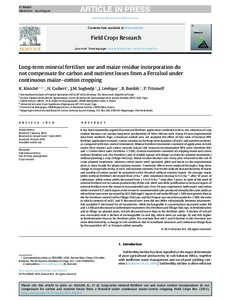| dc.contributor.author | Kintché, K. |
| dc.contributor.author | Guibert, H. |
| dc.contributor.author | Sogbedji, J.M. |
| dc.contributor.author | Levêque, J. |
| dc.contributor.author | Bonfoh, Bassirou |
| dc.contributor.author | Tittonell, Pablo A. |
| dc.date.accessioned | 2019-12-04T10:58:02Z |
| dc.date.available | 2019-12-04T10:58:02Z |
| dc.date.issued | 2015 |
| dc.identifier.citation | Kintché, K., Guibert, H., Sogbedji, J.M., Levêque, J., Bonfoh, B., & Tittonell, P. (2015). Long-term mineral fertiliser use and maize residue incorporation do not compensate for carbon and nutrient losses from a Ferralsol under continuous maize–cotton cropping. Field Crops Research. |
| dc.identifier.issn | 0378-4290 |
| dc.identifier.uri | https://hdl.handle.net/20.500.12478/901 |
| dc.description | Article in press |
| dc.description.abstract | It has been repeatedly argued that mineral fertiliser application combined with in situ retention of crop residue biomass can sustain long-term productivity of West African soils. Using 20-year experimental data from southern Togo, a biannual rainfall area, we analysed the effect of two rates of mineral NPK fertiliser application to maize–cotton rotation on the long-term dynamics of soil C and nutrient contents, as compared with two control treatments. Mineral fertiliser treatments consisted of application to both maize (first season) and cotton (second season) the research-recommended NPK rates (Fertiliser-RR) and 1.5 times these rates (Fertiliser-1.5 RR). Control treatments consisted of cropping maize and cotton without fertiliser use (No-Fertiliser) and of double annual soil tillage (as done for planted treatments) without planting a crop (Tillage-NoCrop). Maize residue biomass was every year returned to the soil of crops planted treatments, whereas cotton stems were uprooted, piled and burnt on the experimental plots as done locally for phyto-sanitary reasons. Treatment effects were analysed through a long-term change in crop productivity, in soil C and nutrient contents. Our results indicate that productivity of maize and notably of cotton cannot be sustained in this Ferralsol without nutrient inputs. On average, maize yields without fertilisers decreased from 2 t ha?1 after woodland clearing to 0.5 t ha?1 after 10 years of cultivation, while cotton yields decreased from 1.5 to 0.5 t ha?1 only after 5 years. In spite of the need of mineral fertiliser use to sustain productivity of this soil, there was little justification to increase inputs of mineral fertiliser over the research recommended rate. Over 20-year experiment, both maize and cotton while received N, P and K inputs at the research-recommended rates produced virtually the same yields as when these rates were increased by 50%. Although C inputs to soil under RR and 1.5 RR were greater than in the No-Fertiliser control (nil for Tillage-NoCrop), and the N input was more favourable for 1.5RR, the rates in which contents of soil C and N decreased over time did not differ substantially between treatments. Soil available P decreased for all treatments, while exchangeable K concentration increased under RR and 1.5 RR and decreased in unfertilised treatments (No-Fertiliser and Tillage-NoCrop). In fertilised plots and in tillage no-planted plots, soil pH decreased more than in No-Fertiliser plots. A decline of soil pH was associated with a decline of exchangeable Ca and Mg, which were on average 20 and 40% higher in fertilised plots than in No-Fertiliser plots. We conclude that soil C and N decline in this Ferralsol was more determined by a change in soil conditions due to woodland clearance and continuous tillage than by the quantities of C or N inputs added annually |
| dc.language.iso | en |
| dc.subject | Crop Rotation |
| dc.subject | Soil Fertility |
| dc.subject | Fertilizers |
| dc.subject | Maize |
| dc.subject | Residues |
| dc.title | Long-term mineral fertiliser use and maize residue incorporation do not compensate for carbon and nutrient losses from a Ferralsol under continuous maize-cotton cropping |
| dc.type | Journal Article |
| dc.description.version | Peer Review |
| cg.contributor.crp | Maize |
| cg.contributor.affiliation | International Institute of Tropical Agriculture |
| cg.contributor.affiliation | Institut Togolais de Recherche Agronomique |
| cg.contributor.affiliation | Centre de Coopération Internationale en Recherche Agronomique pour le Développement |
| cg.contributor.affiliation | Université de Lomé |
| cg.contributor.affiliation | Université de Bourgogne |
| cg.contributor.affiliation | Wageningen University and Research Centre |
| cg.coverage.region | Africa South Of Sahara |
| cg.coverage.country | Congo, Dr |
| cg.isijournal | ISI Journal |
| cg.authorship.types | CGIAR and developing country institute |
| cg.iitasubject | Integrated Soil Fertility Management |
| cg.iitasubject | Soil Ferility |
| cg.iitasubject | Crop System |
| cg.iitasubject | Maize |
| cg.journal | Field Crops Research |
| cg.howpublished | Formally Published |
| cg.accessibilitystatus | Limited Access |
| local.dspaceid | 76400 |
| cg.identifier.doi | https://dx.doi.org/10.1016/j.frc.2015.04.019 |

